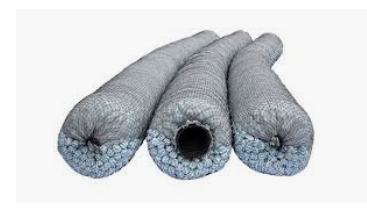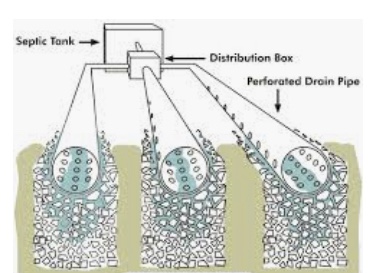
If you live in the country (or are building outside of the city limits) your home requires its own wastewater treatment system otherwise known as a septic system. The above diagram shows the components of a septic system which is basically a tank and a drainfield. Just to give you a short little lesson, ALL THE WATER leaving your home goes first to the septic tank and then slowly to the drainfield. Any solids that might be contained in the water (i.e. toilet paper, garbage disposal remnants, or poo) get trapped in the tank. The drainfield then slowly and consistently absorbs all the water coming out of the tank. Because so much solid material gets trapped within the tank, it must be pumped every 3-5 years. If the solids are not removed regularly, they build up and then eventually seep out to the lateral field and can clog up the soil. This is NOT good. In order for your septic system to work properly, the soil must act like a sponge that constantly soaks up water. Overwhelming the “sponge” with solid matter will stop that absorption.
The soil plays a HUGE role in how your septic system works. Therefore prior to installing a septic system your installer must take a soil percolation test. This helps us determine if the ground is suitable for a conventional septic system. (There are other types of wastewater systems, but the most common and the most desired wastewater system is the conventional septic system). Currently, what most installers are using for their lateral field product is a bundled expanded polystyrene synthetic aggregate lateral. See the picture below…

Here is another picture of this type of lateral to give you a better view of this product. Basically there is some piping down the middle with holes in it surrounded by the synthetic aggregate (which actually looks like packaging peanuts). The piping allows for the water to flow through it and the aggregate helps provide the extra “space” underground for water to flow to.

Most septic installers currently use this type of lateral product. Understand that the point of a lateral field is to create space underground and work with the existing soil to absorb water effectively. These packaging peanuts do just that — they help create space under ground so the soil can slowly absorb the water being fed to it.
Southwick Liquid Waste is currently using this type of bundled synthetic aggregate but we are moving to a new type of lateral field product. (I use the word “new” — it is “new” to our area of Nebraska but not new in the world of lateral fields). We will soon be installing a perforated pipe lateral field bedded in tire chips. Why this and not the bundled synthetic aggregate? What we like about the perforated pipe lateral is we can make access points using the perforated pipe that allows us to hook our vacuum trucks up to and clear the lines out. We can’t do that with the bundled lateral as the pipping would collapse upon vacuuming. With the perforated pipe and tire chips we can create the extra space (just like the synthetic aggregate does) but we can provide a sturdy pipe that will help us maintain the lateral years after it is installed. See the diagram below:

As you can see in this diagram, the piping allows the water to flow through it and then into the media (tire chips) and then eventually into the soil.

Using media in septic systems whether it be synthetic aggregate, gravel or tire chips increases the space we need to create underground. And, in our area of Nebraska with the higher clay content, this works very efficiently.
You might understand this as well, the final treatment of the wastewater takes place in the soil. The drainfield, no matter what type of lateral product is used, is simply an absorption field. The aggregate used, be it synthetic, gravel or tire chips, it does not treat the wastewater it only helps in the absorption process.
Finally, because we are working with the soil, there are certain concessions we have to make with Mother Nature. One such concession happens during installation. We cannot install a septic system when the ground is wet. We need to install when the soil is dry. Digging in wet soil will cause smearing and make the soil seal up when we need to keep it porous and open. This can get frustrating for both installer and customer during rainy seasons/wet months as we have shorter windows of opportunity to dig! It is also why we can’t install during the winter months — we can’t work with frozen soil much better than wet soil! Our typical install season is usually between April and November. Every year varies in its rain and snow fall amounts so we are constantly installing around Mother Nature’s schedule.
But installation isn’t the only area where we have to work around Mother Nature! We also have to be patient AFTER the installation process. Once the system is installed, we have to leave the disturbed soil mounded up around the tank and especially the lateral field. The ground needs to settle around these components as naturally as possible for the best possible final product and the longest lasting system. After we are done, the ground will look something like what I have pictured below:

After about 6 months of settling, then the customer can perform the final grade and level off the area, but not allowing plenty of time for the soil to naturally settle can cause premature failure of your septic system.
